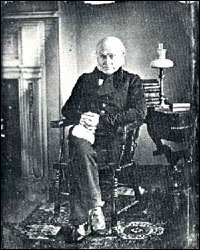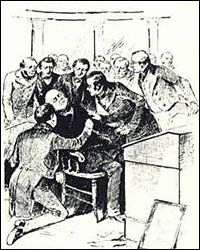By Casey Olson, USCHS Intern
On November 7, 1830, John Quincy Adams wrote in his diary of his landslide election to the U.S. House of Representatives six days earlier: “My election as President of the United States was not half so gratifying to my inmost soul. No election or appointment conferred upon me ever gave me so much pleasure.” Less than two years after losing to Andrew Jackson in his bid for reelection as President, John Quincy Adams relished this new opportunity to serve his country in yet another capacity, to sound his voice again in the nation’s capital on the vital issues of his day. This he would do for the remaining sixteen years of his life, demonstrating marvelous courage and conviction, eloquence and wit, even in the fiery face of intense adversity.

At age 64, John Quincy Adams was no ordinary freshman Congressman. This son of Revolutionary patriots John and Abigail Adams had already accumulated a lifetime of experience in public service in offices such as Minister to the Hague, Emissary to England, Minister to Prussia, State Senator, United States Senator, Minister to Russia, Head of the American mission to negotiate peace with England, Minister to England, Secretary of State, and, of course, President of the United States. Adams had been privileged to know personally such legendary figures as George Washington, Benjamin Franklin, Thomas Jefferson, John Hancock, and James Madison. He also had experience working with James Monroe, John Marshall, Henry Clay, John C. Calhoun, Daniel Webster, Andrew Jackson, John Tyler, James Buchanan, and Jefferson Davis.
The aura of prestige and experience accompanying John Quincy Adams appealed to his 50,000 constituents of the “Old Colony,” the area founded just south of Boston, Massachusetts, by the Pilgrims some 200 years earlier. Adams himself was of Puritan ancestry, “one of the representatives of that extraordinary breed,” wrote John F. Kennedy, “harsh and intractable, like the rocky New England countryside, which colored his attitude toward the world at large.” The farmers, miners, fishermen and factory workers who elected Adams knew of his abilities and his fierce determination. They shared his vision of a federal government dedicated to the nation’s economic development through the construction of bridges, turnpikes and canals, post offices, and factories.
John Quincy Adams was sworn in as a United States Representative on December 5, 1831, and seven days later was appointed chairman of the Committee of Manufactures. In this position, Adams championed the role of factories and manufacturing as a means of developing the nation’s economy and a way to become less dependent on European goods. At the same time, he warned against worker exploitation and other negative effects of industrialization, having witnessed them first-hand in his travels abroad.
Adams also used his influence to advocate his ideal of a federal “internal improvement” system. In this system, tariffs would be set to protect American goods in the domestic marketplace, and revenue from frontier land sales would serve to create a federal-funded, national network of transportation and communication. Adams believed this system would tie the various agricultural, industrial, and commercial economies of the nation’s different geographical regions together, uniting them in prosperity and halting the pattern of sectionalism and slippage toward civil war. He faced formidable opposition, though, from fellow House members who opted instead for the proposals and policies of other persuasive leaders like President Jackson, Senator John C. Calhoun, or Senator Thomas Hart Benton. Each of these was a warrior in his own right, advancing his own ideas on the turbulent issues of national finances, protective tariffs, and Westward expansion.
It was, however, on that most delicate, that most controversial issue of the time, slavery, that John Quincy Adams sounded his voice most frequently and most passionately. Adams first became involved in the slavery debate in 1835, when the New York-based Anti-Slavery Society began a sweeping campaign to flood the nation with abolitionist literature. When anti-slavery newspapers and pamphlets reached the South late that year, worried and offended southern activists responded by illegally intercepting and destroying the tracts. Tempers and passions raged on both sides, cyclically fueling one another. However, due to the illicit actions employed in blocking the spread of abolitionist literature, the nature of the slavery debate had changed. It was no longer just a moral battle waged by militant abolitionists against defensive slaveholders. Coupled with the curtailment of free speech, it became a legal issue as well. For this reason, the debate on slavery was enlarged to accommodate a new host of voices, concerns and ideas.
By this time, John Quincy Adams had been presenting anti-slavery petitions in the House for four years. In early 1836, these petitions became ever more numerous, reaching into the tens of thousands. Abolitionists capitalized on the right to petition as a vital method of protest against southern state governments and the Jackson administration, both of which endorsed and even assisted in stifling the spread of abolitionist literature. Reacting to the deluge of petitions, South Carolina Representative John Henry Hammond moved that any petition dealing with slavery be discarded “peremptorily,” and without mention. A debate erupted in the House over the constitutional right to petition. After a week of heated discussion and flying accusations, a committee was formed for the purpose of devising a compromise. Several months later, the committee presented three resolutions: 1) That Congress was not constitutionally authorized to legislate against slavery in southern states. 2) That Congress “ought not” legislate against slavery in the District of Columbia. 3) That any petition even remotely related to the topic of slavery be automatically banned from mention or discussion in the House.
The resolutions were passed in a gesture of compromise and pacification to mitigate southern tension over the question of slavery’s abolishment. But John Quincy Adams saw no room for compromise on this matter. He viewed the first two resolutions as misguided and flawed deductions of constitutional law; the third, which eventually came to be known as the gag rule, an outright infraction of the Bill of Right’s guarantee of the right to petition. Coerced by conscience and undaunted by opposition, Adams began a personal crusade against the resolutions, using every opportunity to attack them and challenge their legality. Employing years of well-honed experience in parliamentary procedure, Adams masterfully manipulated House proceedings in order to gain opportunities to denounce the gag rule. Because the resolutions were not standing House rules and had to be renewed each session, he often found ways to read anti-slavery petitions before the resolutions could be reinstated. His audacious behavior earned him many enemies. In 1837, Adams began receiving death threats, and by 1839 he was receiving roughly twelve per month.
Still, John Quincy Adams pressed on. In time he received from his colleagues the nickname “Old Man Eloquent” because of the frequency and ferocity of his attacks against the resolutions. Despite his boldness, Adams remained essentially alone in his cause, a fact that allowed his opponents to pass a standing gag rule in 1840, which no longer required renewal. But Adams found other ways to continue his crusade. Occasionally, he succeeded in tricking southern Congressmen into debates on slavery, attacking them on the issue and forcing them to defend themselves. Sometimes these scenarios lasted for days.
In all House proceedings, Adams was purposely contentious and controversial, using every available means to achieve his objective of stirring up debate on slavery. He intentionally baited irate House members to censure him for his conduct. When they did, he employed the time granted him for defense to expound his views on slavery-related issues. On one such occasion, Adams spoke for two weeks on his defense and threatened to go on for another unless the House tabled the censure resolution against him. The resolution was tabled, and Adams emerged doubly successful, for he had used those two weeks to denounce slaveholders for abusing slaves as well as free abolitionists, whose constitutional rights of petition, speech, and the press had been circumscribed. One House rival, Representative Henry Wise, called Adams “the acutest, the astutest, the archest enemy of southern slavery that ever existed.”
It was precisely that rising characterization of John Quincy Adams that led his name to be reviled in the South and celebrated in the North and East. No wonder, then, that in 1841 abolitionist leaders requested Adams to defend before the Supreme Court the thirty-three Africans involved in seizing the slave ship Amistad. A victory in this case would represent a symbolic victory for the civil rights of slaves and inhumanely- dispersed Africans everywhere. Adams delivered a nine-hour address before the Supreme Court, a speech hailed by Justice Joseph Story “for its power, for its bitter sarcasm, and for its dealing with topics far beyond the record and points of discussion.” The captive defendants were freed, and hundreds of copies of Adam’s speech were published throughout the North.
Three years later, in December of 1844, John Quincy Adams enjoyed another victory, perhaps his greatest. As Congress convened, Adams, as was his custom, moved for the repeal of the gag rule. Only this time, he finally had the support he needed in the House. After nine years of both advancing and enduring relentless reproach, Adams finally witnessed the end of the gag rule. For him it signaled a triumph, like that of the Amistad decision, equally real and symbolic. “Blessed, forever blessed be the name of God!” wrote the weary Congressman in his diary.

Over the next several years, the Representative from Massachusetts fought to preserve the delicate balance between the Union’s so-called free and slave states. To that end, he opposed the annexation of Texas and the war with Mexico, and later advocated the annexation of Oregon to offset the South’s acquisition of Texas. His last vote in the House, which he used to deny honors to generals who fought in the war with Mexico, came on February 21, 1848. Moments later, he suddenly clasped his desk as a lethal stroke set in. As the old man sunk in his chair, a voice rang through the House of Representatives: “Mr. Adams is dying!” He was lifted onto a sofa and carried first to the Rotunda, and then to the Speaker’s room. To his huddling colleagues, Adams whispered, “Thank the officers of the House,” and later, “This is the end of earth, but I am composed.” Then he passed into a coma, in which he stayed until his death two days later.
“Know ye not that a great man is fallen?” proclaimed Joshua Bates in a stirring funeral sermon. “No man ever served his country longer, more faithfully, with higher motives and a purer patriotism. History, I say, will do him justice.”
To a great extent, history has indeed done justice to John Quincy Adams. Spurred by a reverencing respect for the courage and fortitude he demonstrated through all those years of stirring controversy on the floor of the U.S. House of Representatives, enemies of Old Man Eloquent stood with his friends to eulogize him as “a sage,” “a Cicero,” and “a great man.” And so we remember him today.
Originally Published: Spring 2000








